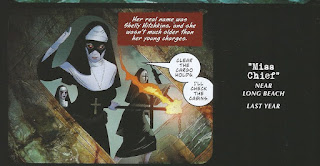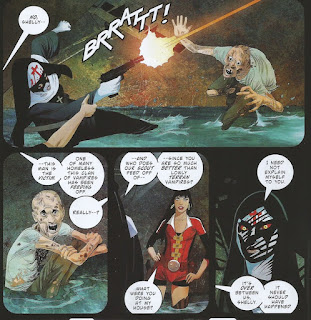Pick of the Brown Bag
December 26, 2019
by
Ray Tate
Welcome to the Pick of the Brown Bag a weekly comic book review blog. Let’s pop the cork and get started. Our contenders this week are Chandra, The Future Foundation, Good Agent, Ghost-Spider and The Old Guard. If you can’t stay for the blogging check out my tweeting: #PickoftheBrownBag,
Available at comixology.com, Dan Membiella’s Good Agent #4 picks up with the Agent possibly being unmasked by White Mother, the racist in charge.
Naturally, it doesn’t end here. We learn the Agent cleverly escaped this fate, and he’s now attempting to find a way out.
The White Mother calls for his death, and we learn her investment in the Norse lies in more than just accoutrements.
The White Mother calls for his death, and we learn her investment in the Norse lies in more than just accoutrements.
Membiella smoothly segues from straight up super-hero action to a supernaturally-tinged dilemma. All of it based on our increasingly sad reality.
Archaeologists long ago debunked the idea of the Vikings discovering America. The Vikings discovered and settled in Newfoundland, Canada. They went no farther. That hasn’t stopped Tiki Torch bearing idiots from claiming otherwise and embracing their Viking heritage, even if they haven’t any. Membiella depicted Tiki Torches in a prior issue, and he takes up the Viking pretense here.
The Norse Gods however do not appear to give a rat’s behind about the racist leanings of humans. The White Mother is a means to an end. A dupe. That's why there's a big ass bomb in the story. Not an ordinary bomb though.
It’s up to the Good Agent, Officer Fatima Chamber and her brave police shepherd Lincoln, who cleverly references the Good Agent’s identity, to stop the Norse loving racists. Good Agent. Good Stuff.
Writer Greg Rucka uses the immortality of his protagonists in The Old Guard to demonstrate their guilt over participating in bad practices before turning over a new leaf in modern times.
Honestly though. It’s nice that they all feel guilty about their part in the enslavement of Vikings. I just can’t lay any blame.
It’s just so far away in a past that operated on different social mores. In addition, the heavily-armed Vikings invaded their territory. That doesn’t mean they should end up as slaves, but it's two entirely different cultures that we in the civilized world know best from movies and television. The real experts can tell you exactly why and how their slave culture works, how it differs from other slave-based cultures, etc.
If Andy and her crew in say the antebellum south owned people, I’d say they should carry a huge weight of guilt on their shoulders. The slave market occurring in so-called civilized times essentially ran on chained innocent bystanders. The purveyors of such injustices are motivated solely by the monetary value they put on human life. They are filth. Plain and simple.
When Andy and her team get wind of an operation, they decide to scotch it. Good on them.
If Andy and her crew in say the antebellum south owned people, I’d say they should carry a huge weight of guilt on their shoulders. The slave market occurring in so-called civilized times essentially ran on chained innocent bystanders. The purveyors of such injustices are motivated solely by the monetary value they put on human life. They are filth. Plain and simple.
When Andy and her team get wind of an operation, they decide to scotch it. Good on them.
They also take out the corrupt members of government that allows this to happen.
It allows for some good Bondish action sequences provided for co-creator and artist Leandro Fernandez and Daniella Miwa. The racing choreography is particularly notable.
The Old Guard opens on the team breaking of a human trafficking ring. This is not the entire story. A mysterious figure with fierce fighting skills confronts the estranged member of Andy’s team Booker. She wants to know the others' whereabouts, and it’s clear she’s up to no good.
The Future Foundation is cancelled after this issue, and man, that sucks. Here’s why, Jeremy Whitley wrote about an offshoot of the Fantastic Four established and partially created by Jonathan Hickman. The book’s rated for teens, but open-minded parents could probably give this book to a kid and not damage him. It’s a little stronger than Whitley’s Unstoppable Wasp thanks to the relationship between Nomad and Lightspeed.
Their relationship provides the best line in the book, spoken by the Reggie of the group Bentley, a clone of the Wizard, an FF Lee/Kirby villain and founder of the Frightful Four.
Hilarious. The lesbian content isn’t the only reason why I recommend Future Foundation. Although I find it adorable that Lightspeed likes Nomad's hands on her ass.
The truth is I never saw that relationship coming. and was a fan mainly because of the celebration of intelligence. All these kids and Dragon Man are super smart.
The truth is I never saw that relationship coming. and was a fan mainly because of the celebration of intelligence. All these kids and Dragon Man are super smart.
Bentley built a pocket dimension in his room. I would say that it’s a TARDIS, but therein lies the problem. Lightspeed rescued them all, but they can’t get out. Until of course one of them comes up with a theory, and everybody begins to contribute. Until finally, and I'm going to spoil it, they figure a means of escape, where everybody lives.
This all started because of Reed Richards’ evil duplicate the Maker being his usual horrid self. The Maker however couldn’t predict his hand-picked horrors would face somebody even more resourceful and dangerous.
This all started because of Reed Richards’ evil duplicate the Maker being his usual horrid self. The Maker however couldn’t predict his hand-picked horrors would face somebody even more resourceful and dangerous.
As he evidenced in the Unstoppable Wasp, Whitley is steeped in Marvel continuity. Even the nonsensical, inane material.
Such as Lyja, which is not to say that I dislike Lyja. She’s a renegade shapeshifting Skrull. That’s cool. Nope. I just hate how she got here. The same goes for Nomad.
Such as Lyja, which is not to say that I dislike Lyja. She’s a renegade shapeshifting Skrull. That’s cool. Nope. I just hate how she got here. The same goes for Nomad.
Heroes Reborn, one of the sloppiest things Marvel ever did, and leaving a big mess for the fixer-uppers. Whitley however elegantly provides an answer to Nomad’s question.
The creativity, the seamless juggling of a multitude of cast members, the inclusivity, the hotness, the Power Pack connection all made Future Foundation a joy to read, and I shall miss it.
The Jackal from Peter Parker’s universe follows Ghost-Spider into her universe. The Jackal for those not in the know has a Jones for Gwen Stacy. Any Gwen Stacy. The dead one. The one he made, and this one. It also doesn’t matter the age, which is extra creepy.
The Jackal is essentially a perverted stalking mad scientist that if not for his goofy appearance would be at home in a Jesus Franco film.
When he meets his counterpart, Miles Warren who works for the crime boss Man-Wolf the lycanthropic John Jameson, he thinks that together they can provide his heart’s desire. A Gwen Stacy of his very own. Miles just wants to stop Gwen and prove his theories correct.
Things go awry from the start. Although Miles figures out a means to capture Gwen. He underestimates his alternate’s viciousness. If you ever saw any of Franco’s films, you’ll know that there aren’t too often any happy endings. Of course, although this is Earth-65, it’s still the Marvel Universe.
The Mary Janes showing up at an opportune time is almost like an homage to the Josie and the Pussycats cartoon. Their imminent danger gives Gwen the necessary adrenaline to feed her symbiotic costume and break out in the nick of time. And there are other little titbits that are just too hilarious and juicy to spill.
Chandra is one giant beautifully directed fight by Harvey Tolibao and Joana Lafuente pitting the fire-based superhero of the title against Tybalt a parasitic demon thing.
When last we saw Tybalt he had teleported to Kaledeshi Chandra’s home, and her mom’s home.
Mom is a scientist/politician and no fainting flower as Tybalt finds out. The attempt on her mom’s life naturally motivates Chandra.
Chandra’s pal Ajani steps in for color, and Tybalt attempts to demean and demoralize Chandra only to discover a fortified strength of character.
This issue of Chandra is the artists’ show, but writer Vita Ayala lays on some pithy dialogue and speech indicating a growth from girl to woman. Chandra made mistakes along the way. Tybalt hoped to exploit them, but she owns up to her past and becomes more powerful as a result.
Although Chandra is tied into Magic the Gathering. I have no idea how. I just saw this as a fantasy based take on Firebrand from the All-Star Squadron. Just to pick a flame-based hero at random. You can also say the Torch or Frankie Raye. Doesn't matter. Chandra distinguishes herself through personality and an almost Green Lantern sense of duty. The setting gives her a wide arena to protect, and even if you never picked up a set of the cards, you’ll still enjoy the book.

































































